
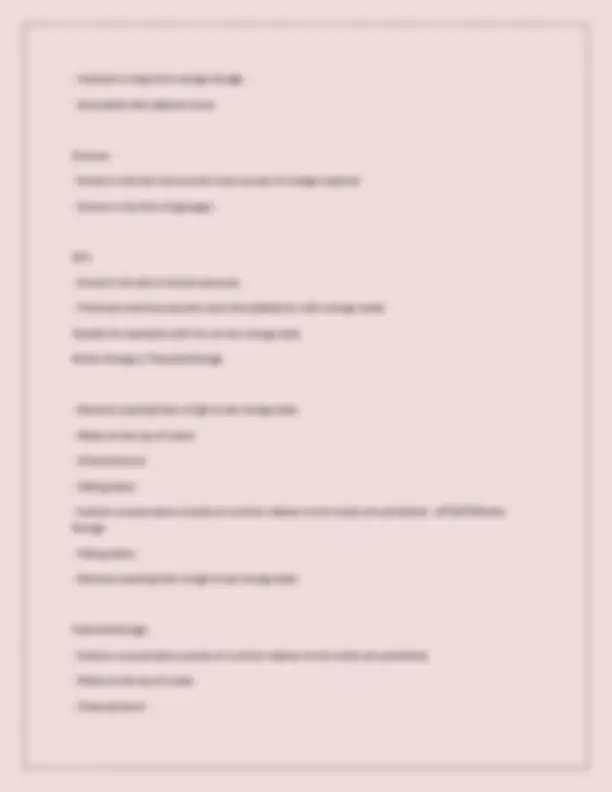

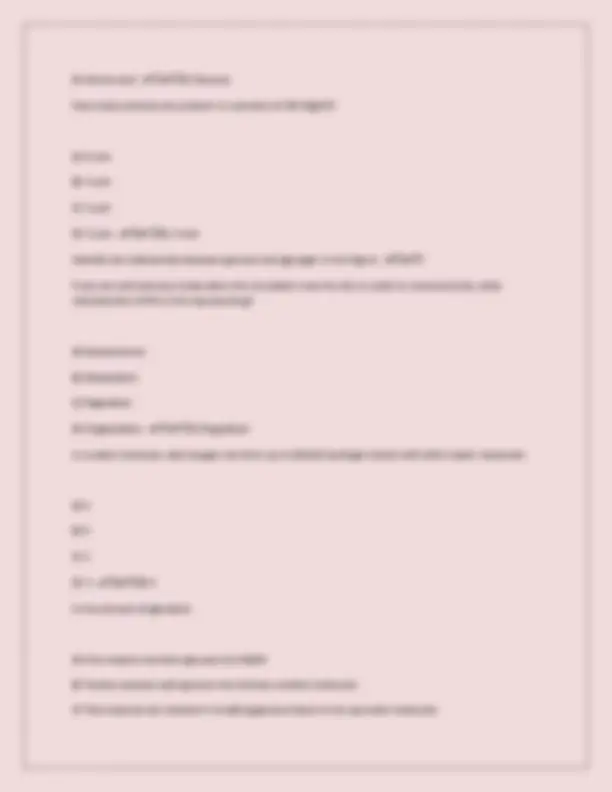


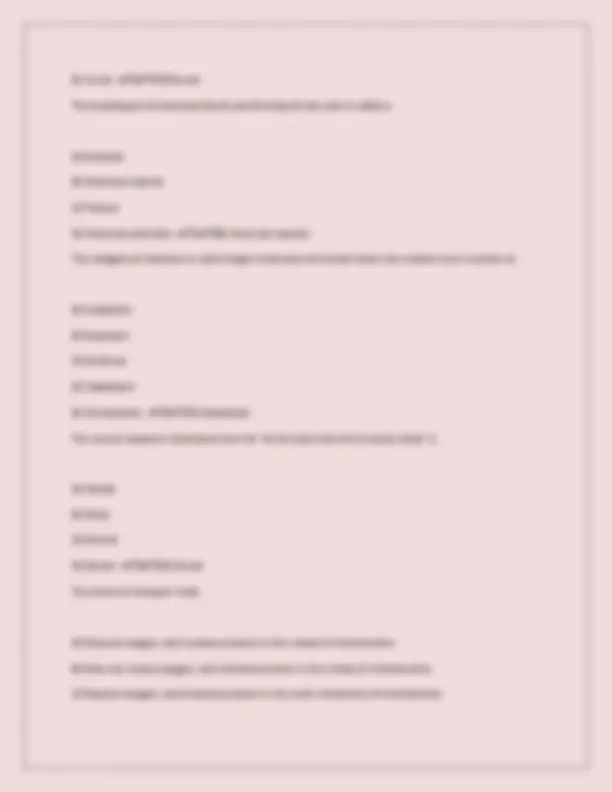
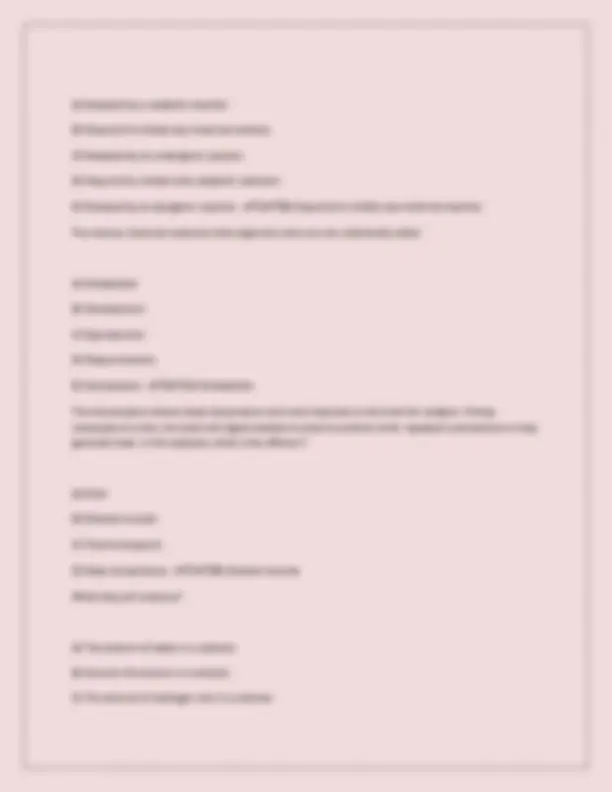
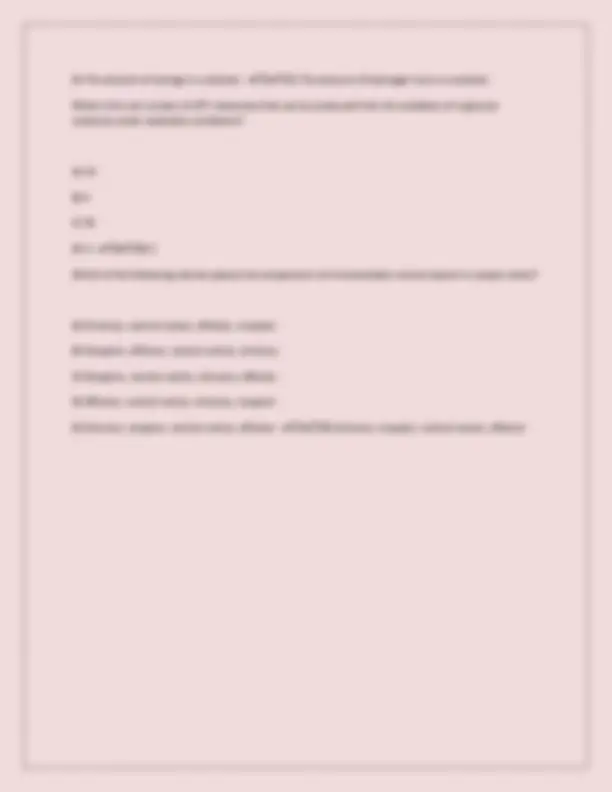


Study with the several resources on Docsity

Earn points by helping other students or get them with a premium plan


Prepare for your exams
Study with the several resources on Docsity

Earn points to download
Earn points by helping other students or get them with a premium plan
Community
Ask the community for help and clear up your study doubts
Discover the best universities in your country according to Docsity users
Free resources
Download our free guides on studying techniques, anxiety management strategies, and thesis advice from Docsity tutors
A wide range of fundamental biological concepts and processes, including the behavior of acids and bases, cellular responsiveness, energy transformations, anatomical terminology, and the regulation of enzymatic reactions. Detailed explanations and examples related to these topics, making it a valuable resource for students studying biology at the high school or university level. The content covers key principles in areas such as chemistry, physiology, and biochemistry, and could be useful for preparing for exams, writing assignments, or deepening one's understanding of core biological mechanisms.
Typology: Exams
1 / 14

This page cannot be seen from the preview
Don't miss anything!









When a strong acid is placed in water, it
A) Dissociates, but does not dissolve B) Dissolves, but does not dissociate C) Dissolves and Dissociates D) Does not dissolve or dissociate - ✔ ✔ C) Dissolves and dissociates When an organism senses and reacts to changes in their internal or external environments, this is an example of
A) Responsiveness B) Metabolism C) Organization D) Reproduction - ✔ ✔ A) Responsiveness When NAD+ becomes NADH, it is being
A) Reduced and releasing chemical energy B) Oxidized and gaining chemical energy C) Reduced and gaining chemical energy D) Oxidized and releasing chemical energy - ✔ ✔ C) Reduced and gaining chemical energy Which anatomical term describes the wrist region
A) Perineal B) Digital C) Olecranal
D) Carpal E) Tarsal - ✔ ✔ D) Carpal Which is a form of energy that is generally unavailable to do any work?
A) Radiant energy B) Mechanical energy C) Sound energy D) Kinetic E) Heat - ✔ ✔ E) Heat Which level of organization in the human body involved two or more tissue types working together to perform specific, complex functions?
A) Organismal level B) Tissue level C) Organ level D) Cellular level - ✔ ✔ C) Organ level
Classify the example or definition with the appropriate type of chemical energy storage molecule. Triglycerides // Glucose // ATP
Enzyme regulation by negative feedback involves
A) Allosteric facilitation of an enzyme by a substrate of its metabolic pathway B) Occupation of the active site of an enzyme so that it catalyzes less efficiently C) Allosteric modification of a substrate by an enzyme of an alternate metabolic pathway D) Enhancement of the active site by a negatively charged substrate E) Allosteric inhibition of an enzyme by a product of its metabolic pathway - ✔ ✔ E) Allosteric inhibition of an enzyme by a product of its metabolic pathway For every atom of carbon in a carbohydrate
A) There are approximately four atoms of hydrogen B) There are approximately two atoms of hydrogen C) There is approximately one atom of hydrogen D) There are approximately three atoms of hydrogen - ✔ ✔ B) There are approximately two atoms of hydrogen Fructose and galactose are isomers of
A) Maltose B) Lactose C) Sucrose D) Glucose - ✔ ✔ D) Glucose Glycogen is a polymer of (blank) molecules
A) Starch B) Fructose C) Glucose
D) Amino acid - ✔ ✔ C) Glucose How many osmoles are present in a solution of 1M MgCl2?
A) 4 osm B) 2 osm C) 1 osm D) 3 osm - ✔ ✔ D) 3 osm Identify the relationship between glucose and glycogen in the figure - ✔ ✔ If you are cold and your body alters the circulation near the skin in order to conserve heat, what characteristic of life is this representing?
A) Reproduction B) Metabolism C) Regulation D) Organization - ✔ ✔ C) Regulation In a water molecule, each oxygen can form up to (blank) hydrogen bonds with other water molecules.
A) 5 B) 4 C) 2 D) 3 - ✔ ✔ D) 2 In the process of glycolysis
A) One enzyme converts glucose into NADH B) Twelve enzymes split glucose into thirteen smaller molecules C) Two enzymes are involved in breaking glucose down to ten pyruvate molecules
A) 2 ATP, 2 NADH+, 3 FADH B) 1 ATP, 3 NADH, 1 FADH C) 2 pyruvates and 2 ATP D) 2 citrates, 4 ATP, and 3 FADH2 - ✔ ✔ B) 1 ATP, 3 NADH, and 1 FADH Place the correct word into each sentence. Not all words will be used. Lower, Energy, Result, Activation, Production, Increase, Chemicals, Catalysts
Enzymes act as __________, speeding up the rate of reactions. Every reaction has a certain amount of ___________ needed to begin. This initial energy is called the energy of _______________. Enzymes are used to _____________ the energy of activation needed to begin a reaction. - ✔ ✔ Catalysts Energy Activation Lower A protein consists of
A) A C-terminal, several nucleic acids, and an N-terminal B) More than 200 amino acids C) Between 3 and 20 amino acids D) An amine group, a carboxyl group, and an R group - ✔ ✔ D) An amine group, a carboxyl group, and an R group A(n) (blank) plane separates the body into superior and inferior parts
A) Frontal B) Sagittal C) Coronal D) Oblique E) Transverse - ✔ ✔ E) Transverse An individual hydrogen bond in a sample of water would be described as
A) Strong and intermolecular B) Strong and intra molecular C) Weak and intramolecular D) Weak and intermolecular - ✔ ✔ D) Weak and intermolecular Building glycogen from glucose molecules is an example of
A) Catabolism B) An exchange reaction C) Anabolism D) Decomposition - ✔ ✔ C) Anabolism Pyruvate undergoes oxidation when it loses electrons to
E) Crural - ✔ ✔ D) Buccal The breaking of old chemical bonds and forming of new ones is called a
A) Reactant B) Chemical reaction C) Product D) Chemical substrate - ✔ ✔ B) Chemical reaction The category of reactions in which larger molecules are broken down into smaller ones is known as
A) Anabolism B) Enzymatic C) Synthesis D) Catabolism E) Homeostasis - ✔ ✔ D) Catabolism The correct anatomic directional term for "at the back side of the human body" is
A) Caudal B) Distal C) Ventral D) Dorsal - ✔ ✔ D) Dorsal The electron transport chain
A) Requires oxygen, and involves proteins in the cristae of mitochondria B) Does not require oxygen, and involved proteins in the cristae of mitochondria C) Requires oxygen, and involved proteins in the outer membrane of mitochondria
D) Does not require oxygen, and involved proteins in the outer membrane of mitochondria - ✔ ✔ A) Requires oxygen, and involved proteins in the cristae of mitochondria The enzyme-substrate complex is
A) Another name for the active site B) The reactants whose chemical reaction the enzyme catalyzes C) The chemical structure formed when the substrate binds to the active site D) A pocket on the substrate that the enzyme recognizes - ✔ ✔ C) The chemical structure formed when the substrate binds to the active site The molecular formula for bicarbonate ion is HCO3-. It is therefore a
A) Polyatomic anion B) Catatonic compound C) Polyatomic cation D) Radioactive isotope - ✔ ✔ C) Polyatomic cation The most common lipids in the body are
A) Steroids, and they are used as signaling molecules in inflammatory responses B) Phospholipids, and they are used as key ingredients of bile salts C) Eicosanoids, and they are used as hormonal messengers D) Glycoproteins, and they are used as backbones for cell membranes E) Triglycerides, and they are used for energy in adipose - ✔ ✔ E) Triglycerides, and they are used for energy in adipose The optimum temperature for most enzymes is around body temperature. If the body temperature is slightly elevated, what effect will this have on enzymatic reactions?
A) Less kinetic energy, so less likely for enzyme and substrate to contact
A) Released by a catabolic reaction B) Required to initiate any chemical reaction C) Released by an endergonic reaction D) Required to initiate only catabolic reactions E) Released by an exergonic reaction - ✔ ✔ B) Required to initiate any chemical reaction The various chemical reactions that organisms carry out are collectively called
A) Metabolism B) Development C) Reproduction D) Responsiveness E) Homeostasis - ✔ ✔ A) Metabolism Thermoreceptors detect body temperature and send impulses to the brain for analysis. If body temperature is low, the brain will signal skeletal muscles to perform brief, repeated contractions to help generate heat. In this example, what is the effector?
A) Brain B) Skeletal muscles C) Thermoreceptors D) Body temperature - ✔ ✔ B) Skeletal muscles What does pH measure?
A) The amount of water in a solution B) Amount of pressure in a solution C) The amount of hydrogen ions in a solution
D) The amount of energy in a solution - ✔ ✔ C) The amount of hydrogen ions in a solution What is the net number of ATP molecules that can be produced from the oxidation of a glucose molecule under anaerobic conditions?
A) 32 B) 4 C) 36 D) 2 - ✔ ✔ D) 2 Which of the following choices places the components of a homeostatic control system in proper order?
A) Stimulus, control center, effector, receptor B) Receptor, effector, control center, stimulus C) Receptor, control center, stimulus, effector D) Effector, control center, stimulus, receptor E) Stimulus, receptor, control center, effector - ✔ ✔ E) Stimulus, receptor, control center, effector